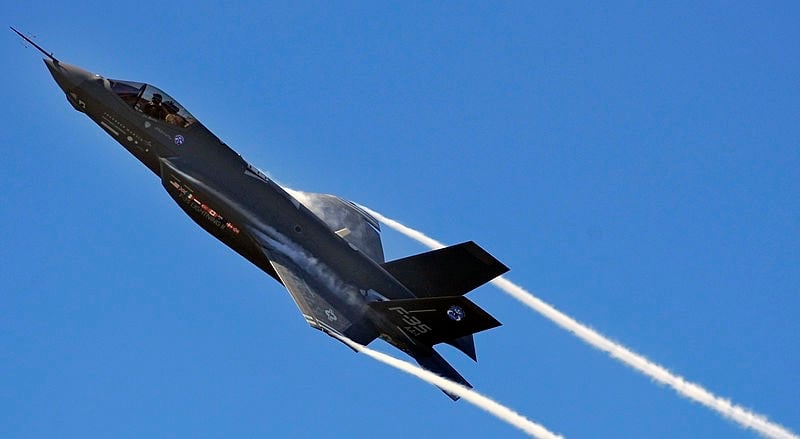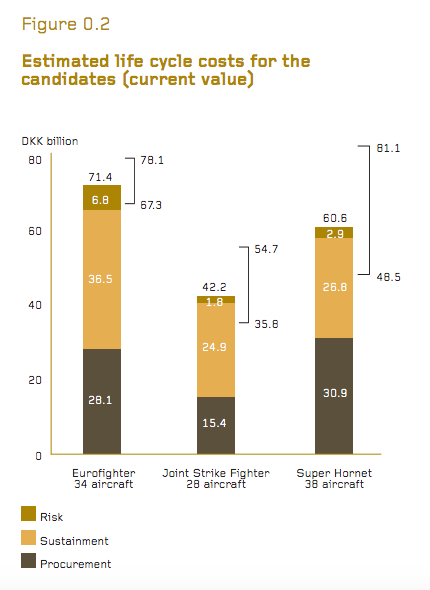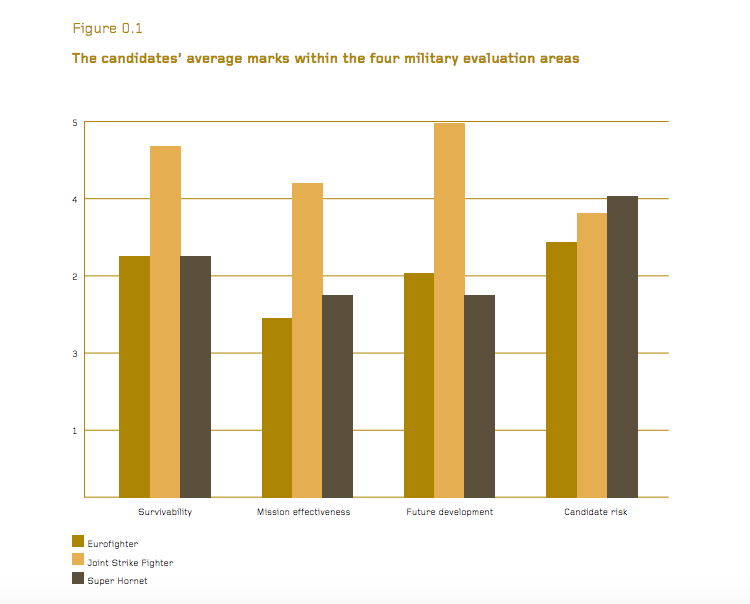F-35 Wins Denmark Competition: Trounces Super Hornet, Eurofighter
Posted on

[UPDATING with Aboulafia analysis of questionable pricing] The F-35 just won a competition — and it wasn’t even close. In every category, from combat performance to cost, the Danish government rated Lockheed’s F-35A Joint Strike Fighter as superior to Airbus’s Eurofighter Typhoon and Boeing’s F/A-18F Super Hornet.
What’s striking here is not that the F-35 won: Denmark was already one of the nine Joint Strike Fighter partner nations and will build part of the plane. Nor is the size of the buy remarkable: Denmark’s a small country and it’s buying just 28 planes (less than the 48 it had initially considered to replace its aging F-16s). The big deal is how confident Denmark seemed in the F-35, resoundingly rejecting widespread criticism of the airplane’s performance and price — though there’s some debate about the latter (see below).

Denmark rated the F-35 higher than the F/A-18E/F Super Hornet and Eurofighter Typhoon in every category.
In a detailed summary of its decision, the Danish government rates all three aircraft in four categories:
- strategic aspects, especially whether the aircraft is used by international partners;
- military aspects, the ability to conduct and survive missions both now and against future threats;
- economic aspects, meaning the cost of buying and sustaining the aircraft in adequate numbers; and
- industrial aspects, whether building that aircraft would benefit Denmark’s industrial base.
That last item is a lock for F-35, on which Denmark is already an industrial partner. The proposed industrial cooperation for F-35 was valued at almost $4 billion (26.5 billion Dutch kroner), compared to $2.8 billion (18.7B DKK) for the Eurofighter and $2.3 billion (15B DKK) for the Super Hornet. But the F-35 also won the other three categories handily, even when it came to cost.

Denmark decided the F-35 would be the least costly option because its longer service life would allow the Danes to buy fewer aircraft.
How did the F-35 win the price war? The Danes argued they would need to buy fewer F-35s (28) than Eurofighters (34) or Super Hornets (38) because the F-35 is designed to last for 8,000 flight hours, while the other aircraft only last 6,000. This 33 percent increase in service life mattered because the Danes chose a 30-year timeframe to evaluate life-cycle costs: a shorter window might have given them a different winner.
The F-18 is also a two-seat aircraft, which increases personnel and training costs, the evaluation noted. (Why the Danes didn’t evaluate the one-seat F/A-18E model is unclear.) Finally, the report said, both procurement cost per plane and cost per flight hour are higher for the Eurofighter than either competitor.
[UPDATE: Leading aviation analyst Richard Aboulafia pointed to me that the procurement prices per plane are dodgy. The F-35A is priced at $80 million, which is the ambitious but no longer implausible target that program manager Lt. Gen. Chris Bogdan says the plane will reach around 2019. But the F/A-18F Super Hornet is priced at a whopping $122 million, when the Navy’s official figure is $57 million and prospective sales are often priced lower.]
The evaluation did acknowledge that the F-35 is a new and unproven aircraft compared to the longer-serving alternatives. In fact, the F-35’s lack of a track record led to the one rating where it lost, a miscellaneous “candidate risk” assessment where the Super Hornet came out on top. But this loss was just one factor buried in the military/tactical evaluation, which F-35 won overall. Again, a different structure to the evaluation, one that weighted such risk more heavily, might have given a different winner.
Conversely, F-35’s newness led to it trouncing its competitors on all other ratings of tactical military value. Its combination of stealth features — to avoid being seen — with advanced sensors and pilot displays — to see better — were cited as carrying the day on survivability and mission effectiveness. The fact that F-35 will be produced in large numbers with regular updates won it the “future development” subcategory.

Denmark rated the F-35 as militarily superior to the alternatives, but more risky.
The international scale and scope of the F-35 program also won it the “strategic” category. The US has partnered with Canada and seven European nations on F-35 (Britain, Italy, the Netherlands, Turkey, Australia, Norway, and Denmark itself), and the plane is likely to sell elsewhere. As a result, the evaluation said that “the broad scope of the group of Joint Strike Fighter users will foster both Denmark’s transatlantic ties and the country’s collaborative relations with a range of European partners.”
By contrast, Eurofighter involves only European partners, not the US, though the evaluation notes . The Hornet family involves only the US and a few partners mostly far outside where Denmark would operate (Finland, Spain, and Switzerland in Europe, plus Australia, Canada, Kuwait, and Malaysia), of which only Australia has yet bought the Super Hornet model.
The Denmark competition was always F-35’s to lose — and a loss here, in one of the nine partner nations, would have struck a major blow to the program. Denmark’s choosing F-35 is not a surprise, but the enthusiasm behind their choice is a major boost.
[UPDATE: “I don’t think Eurofighter had a chance in this market. It was Super Hornet versus F-35, and Russia’s aggressive posture in the region proved to be Lockheed Martin’s best friend,” Aboulafia told me. F-35’s stealth, sensors, and other advanced combat features look very attractive against Russian “anti-access/area denial” systems designed to detect and destroy conventional fighters. “As for Eurofighter,” he said “it has the costs of an F-35 without the modern features.”]
Subscribe to our newsletter
Promotions, new products and sales. Directly to your inbox.
